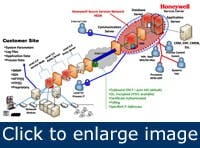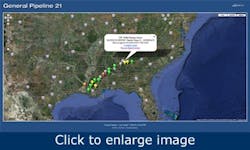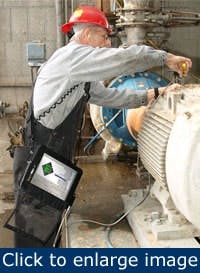Best friend?
Recent years have seen a steady increase in the demand for remote asset management services, and both the number and scope of service offerings is growing. While historically, companies have been slow to relinquish operational control to outsiders, convergence of business and technology challenges and improvements in information technology (IT) security are alleviating their concerns. Those that manage to overcome any initial degree of wariness quickly realize the rewards of strategically outsourcing surveillance, analysis, diagnostic and maintenance activities to remote service providers.
Driven by the economy
When the recent global recession wreaked havoc on the demand for manufactured goods, drastic measures were taken. “Plants have scaled back their operating time,” says Steve Carlson, global product manager of InSite Services for Rockwell Automation (www.ra.rockwell.com). “Many that once ran 24/7 are now one shift only, so the production in that shift must be flawless.”
It’s not just in discrete manufacturing. “Equipment uptime and production levels are especially important in process plants,” adds Vlad Bacalu, product manager for Advanced Technology Services (ATS), www.advancedtech.com. “Very few customers have redundant equipment and, therefore, they can’t shift production to other equipment. This makes uptime essential.”
Consequently, the methods chosen to ensure reliable uptime increasingly involve third-party expertise. "Because there is increased pressure on manufacturers to do more with less, they are turning to solutions that maximize maintenance timeliness and effectiveness,” says John Schroeder, business development manager, Remote Services, ABB (www.abb.com). “Remote access typically provides significantly improved technical support response times. Having these services available 24/7 is hugely beneficial to manufacturers.”
[pullquote]Reducing downtime by even 10 minutes can generate significant cost savings. Some downtime incidents will be eliminated completely as a result of remote predictive maintenance services. Cost efficiencies are further amplified when remote monitoring equipment and software is bundled with a service contract, because it allows the customer to avoid the capital expense of purchasing the technology while also reducing associated labor and training costs.
Ease workforce constraints
Skills gaps in the employee base are widening because of high attrition and low replacement rates, and employers are challenged to keep up. “I think we will come out of the recession with the skills shortage more acute. Many companies cut personnel during the last 12 to 18 months, and those people are generally not going to come back,” predicts Jonathan Hakim, president, Azima DLI (www.azimadli.com). “Additionally, we’ve found that when companies launch reliability programs, they often are defunct in two or three years because it is very hard to develop and sustain the expertise internally.”
Remote services can support a move to the next level. “All of our predictive work is outsourced because we don’t have reliability experts or trained people in the field who can make the call on a unit’s overall mechanical status,” says Rasmus Dorrington, rotating equipment engineer for Colonial Pipeline Company (www.colpipe.com). “Some of our pumping units were installed in the early 1960s. We used to rely on preventive practices, but two years ago we began some basic predictive maintenance, including overall vibration readings, oil sampling and analysis on the mainline piping unit.” The Atlanta, Ga., facility recently added full-spectrum vibration analysis with help from Azima DLI.
“Greater skill sets and knowledge are required to support open technology, and it is difficult to maintain an adequate level of expertise at every site,” says Shawn Gold, remote services global program manager for Open Systems Services at Honeywell (www.honeywell.com). “For example, a distributed control system itself is not generally complex, but running it on top of a Windows environment increases the workload.”
Remote service providers fill the labor gap with a supplemental workforce. “We are keenly aware of our customers’ requirements to use their technology investments in the most cost effective way,” says Bruce Oyler, manager of Global Asset Reliability Services for Emerson Process Management (www.emersonprocess.com). “We augment plants that have complicated equipment, but lack in-house expertise, and we provide second-opinion services, which are good for resolving disputes about whether an OEM or the plant owns a problem. Our intent is to give our customers service capability where they lack the skill sets or funding to build a program internally.”
Support sophisticated technology
Keeping up with constantly changing and highly sophisticated information systems is an ongoing effort. “The technology in the plant is not getting any easier to support,” says Carlson. “Customers are increasingly installing control, manufacturing execution and process systems that are integrated together over the network and supply chain, which increases the complexity of the systems.”
{pb}Modern process control systems are built to gather a lot more data than in the past, and companies are drowning in data. “In addition, device costs are going down, particularly wireless technology, which leads to a greater percentage of plants being monitored," says Hakim. “This increases the premium on the ability to make sense of the data and makes remote monitoring services like ours more valuable.”
In general, corporate IT system administrators are concerned about protecting the data, while the process IT personnel are more concerned with protecting plant processes and consider a little data loss acceptable, according to Gold. "Our customers need someone who understands and appreciates the process considerations.”
Companies are trying to get more juice out of their assets, Hakim adds. “They want to harvest and centralize data to make better sense of it and have the data visible to the operating side of the plant rather than siloed in a maintenance department computer.”
Overcome security concerns
Although the benefits of the remote service model are easy to recognize, the primary sales and implementation barrier for remote online systems concerns IT policies and firewalls. They are, however, being overcome. “It is an urban legend that plants won’t allow remote connections. The IT space has been accessing enterprise business systems like SAP and Oracle remotely for years,” says Carlson.
“Data concerns are arguably more imaginary than real,” Hakim agrees. “What would someone do with a bunch of vibration data if they could get their hands on it?”
Like online banking, a cultural shift is underway, but security remains an issue for some. “We find our customers are cautious,” adds Gold. “They want to improve their maintenance and systems, but worry about security, trade secrets and relinquishing control. A minority immediately sees the value of remote services, but the majority is guarded, particularly if there is potential for a safety incident to occur or when critical distributed control systems are involved.”
Figure 1. Honeywell’s security protocol is very restrictive with two-factor authentication, and all appropriate security standards are applied. The customer completely controls all data going in and out, and the information is segmented in a secure, isolated environment, even within Honeywell.
To ensure the safety and integrity of customer information, remote service providers are taking active measures at multiple levels (Figure 1).
For instance, ABB’s secure remote access process is documented and shared with the customer. Key security measures include registered users with limited privileges, strong authentication, encrypted outbound-only communications and logs of all remote activities. Secure control room environments are offered for customers who require an additional level of security. In addition, the customer maintains complete control over when an ABB engineer is allowed remote access and what data is allowed to be viewed and transferred. The customer can monitor the entire remote session and end it at any time.
This approach is similar to the others but some customers still need convincing. “There remain issues with getting on the customer’s network to fully and automatically monitor their systems,” says Bacalu. He explains that condition-monitoring data is read-only and variables limit the data ATS receives. In most cases, the customer moves its own data into an ATS-specific data table, which is then transferred to the ATS network. In other instances, the customer’s control networks are separate from the IT networks and ATS ties directly into its control data. ATS does not send data to controllers or machines.
Remote service offerings are robust
The scope of available remote services has never been larger. From providing IT support and disaster recovery services to troubleshooting faulty Ethernet modules, a problem in a Cisco switch, or a data-dropping barcode reader, the possibilities for remote service abound. The services might fill niche skills gaps, as when electrical technicians lack expertise in batch management, historians and MES systems, or they might encompass the entire operation.
Some providers deliver across-the-board managed services for plant and IT assets, while others are dedicated to specific equipment condition-monitoring techniques. Depending on the customer, services might be provided at the corporate level via the corporate intranet or one-off at individual sites. Service contracts are most commonly for a term of one year or more.
Most remote service vendors provide some degree of monitoring, analysis and diagnostic services, and automatically notify the customer when corrective actions are required. If the customer needs assistance with a work task or repair, the vendors might provide phone or on-site support. At a few very large facilities, the vendor might staff service personnel on site.
{pb}“In automation systems, most support and maintenance that does not require a wrench or screwdriver can be handled remotely,” says Carlson. “Anything an engineer can do from a laptop in the plant, we can do remotely. If a screwdriver or wrench is needed, we’ll reach out to the plant floor technicians and guide them through the appropriate action. If they don’t have the necessary skills, we’ll dispatch field engineers with the right knowledge and parts so they can get in and out of the customer site quickly.”
Like Rockwell, Emerson personnel don’t normally do wrench turning, although they can oversee repairs or assist with certain types of repairs, such as manually realigning and balancing equipment. “As long as the customer can transfer data and we can read it, then we can analyze it,” says Oyler. “We watch for bearing condition faults, misalignments, imbalances, excessive temperatures, compressor or turbine efficiencies, motor condition and other key indicators.”
Full-service options
Rockwell Automation’s foundation for remote services is TechConnect Support, a network of customer support centers offering real-time phone support for software and technology, product updates and electronic tools. Remote monitoring and diagnostic services for process and drive systems were added, and by April 2009, a full line of managed services for the complete lifecycle of manufacturing technology was launched under the InSite Services brand.
InSite Services takes a holistic, site- or system-wide approach to managed services, with capabilities for remote and on-site surveillance, diagnostics, administration, knowledge management, optimization and visualization.
- Surveillance — Remote monitoring and proactive notification
- Diagnostics — Remote system analysis and troubleshooting
- Administration — Life-cycle application and system management
- Knowledge — Technical support and system information database
- Optimization — System performance improvement and development
- Visualization — Web-based machine, process and production intelligence
(Source: Rockwell Automation)
Most InSite Services contracts include the diagnostics, knowledge and surveillance services. Most customers add scope over the life of a contract, such as disaster recovery, system performance management and patch management. “We literally become a virtual extension of the organization,” explains Carlson. “With our global incident management system, global phone system, global knowledge base and remote technology, there is always a Rockwell resource available for any situation at any time.”
ABB likewise offers remote services for virtually all aspects of a plant, including automation, equipment health and performance, mechanics, electrification, electronics, production and quality. ABB’s Remote Diagnostic Services (RDS) solution consists of condition monitoring, diagnostics, troubleshooting, and predictive and preventive maintenance services. Remote optimization services for systems, processes and machines also are offered.
“ABB’s remote diagnostic services provide our customers with a cost-effective and efficient way to automate data collection, conduct network analysis or system health checks, evaluate and optimize control systems, and Web-enable the analysis and troubleshooting of plant equipment,” says Schroeder.
ABB has integrated its SupportLine help desk and Remote Connectivity infrastructure. This provides the customer with a single point of contact for both remote service and SupportLine requests. The integrated infrastructure also receives automatic notifications from assets. The same escalation process is used for both customer calls and automatic notifications.
“Honeywell has been using the Internet and dial-up capabilities for at least 10 years in a very structured way,” says Gold. The company’s Open Systems Services includes both onsite and remote system performance-monitoring activities. Honeywell also offers Loop Scout, which remotely monitors and reports on control system loop performance; Benefits Guardianship Maximum, which optimizes advanced process control (APC) performance remotely; and the Technical Assistance Center, which provides remote software and hardware support and troubleshooting.
The remote services generating the most interest include system performance monitoring and management, along with backup, antivirus, patch and release management services. “It doesn’t make sense for companies to do these tasks themselves if they lack the expertise to conduct complex analysis of multiple parameters,” explains Gold.
Honeywell’s unique expertise associated with its control systems enables them to develop very accurate and robust models to determine how a system is performing, its chance of failure and how to prevent problems from occurring. The learning process is continuous as new information is received from the company’s expansive customer base.
Emerson supports rotating equipment, including turbines, compressors, HVAC, pumps, motors, boilers, heat exchangers and cooling towers. The company’s Global Asset Reliability Services include remote predictive diagnostics of mechanical equipment, electrical equipment, instrumentation and control valves.
It performs remote machinery health monitoring using data from portable vibration, infrared and ultrasound devices, as well as online prediction and performance technologies. “For customers lacking adequate reliability engineers, vibration analysts or other skilled resources in house, we’ll teach them how to collect the data and analyze it for them,” says Oyler.
Emerson also performs remote services for some OEMs. For instance, a compressor manufacturer has Emerson monitoring its compressors at customer sites to support its extended warranty program.
{pb}Specialists handle niches
Figure 2. Machine analysts and customers can securely access machine health information from any location served by the Internet.
Boston-based Azima DLI believes it is the largest independent condition monitoring service supplier in North America. Its Watchman Reliability Services organization monitors, gathers and interprets data on vibration, temperature and oil quality, and provides information to the customer on how to manage their maintenance most efficiently (Figure 2).
“The condition monitoring industry is evolving with the separation of diagnostics from information gathering,” says Hakim. “Traditionally, condition monitoring in industrial plants involved internal activities performed by qualified analysts who would collect, analyze, interpret, screen and report information. Today, collection is increasingly separate from analysis because it is more efficient to bring the data to an analyst rather than vice versa, but also because skills shortages inside industrial plants limit their ability to interpret and analyze the data."
Azima DLI offers both online and handheld data collection, and most customers choose a combination of the two services. Online systems installed on-site enable the most critical assets to be automatically monitored (Figure 3). For less critical equipment, data is gathered on handheld devices and uploaded to central database for analysis and interpretation by Azima (Figure 4). “Both approaches are needed because even though the cost of remote monitoring technology has fallen over the years, it still does not make economic sense to install it on all equipment,” says Hakim.
Figure 3. Web-based maps provide customers and Azima DLI analysts quick overviews of automated online machinery condition monitoring systems along a petroleum pipeline in the Southeast United States. (imagery provided courtesy of TerraMetrics, map data provided courtesy of Google/INEGI, machine data courtesy Azima DLI).
For customers with a high level of automation, especially those in the process industry with elaborate integrated control systems, ATS is able to tie into the control systems to monitor machine performance and condition and make maintenance decisions based on its status and process variables. The company is also getting into diagnostics. “All the modern motor drives, PLC controllers, etc., have built in diagnostics codes,” says Bacalu. “The information is readily available in the drives but the customers rarely look at it. They just want the machine to run and tend to ignore the data.”
Figure 4. For remotely supported on-site condition monitoring, plant personnel collect machine vibration data onsite using Windows-based tablet computers and then replicate this data to the secure data center through automated means.
Production information is also provided. “Once there is visibility into the number of products produced on a machine, the operator knows someone is watching and will try to produce more products, more efficiently,” explains Bacalu. The company’s long-term goal is to add product quality data to the mix and have the capability to measure overall equipment effectiveness (OEE) from afar.
Separately, ATS developed iTWatch Managed Services as a tool to manage the information technology (IT) assets within an organization remotely. The services range from monitoring, patching and optimization of PCs, laptops, servers and network equipment to data backup and replication services. “Because IT protocols are standardized, remote monitoring services drive efficiencies and save precious capital resource dollars,” says Bacalu. Volvo Construction Equipment deployed iTWatch services, including virtualization of its IT enterprise, saving the company millions of dollars annually.
Substantial growth in remote services is expected to continue into the foreseeable future as conditions force companies to view outsourcing as a value-added business model, and as security advancements and the passage of time make the prospect a little less foreboding.
The emergence and adoption of new communication standards will further expand the scope of assets managed remotely and simplify the task itself. Bacalu predicts, “The factory of the future will have a lot more equipment conditions monitored remotely and the equipment itself will call for maintenance based on parameters before an actual failure occurs.”
E-mail Contributing Editor Sheila Kennedy, managing director of Additive Communications, at [email protected].




